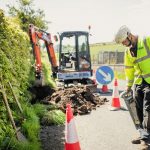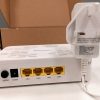Buckinghamshire and Hertfordshire Finish First “Fibre Broadband” Rollout
The joint £18.06m Connected Counties project, which involves Hertfordshire and Buckinghamshire in England, appears to have reached its original Phase One contract goal of 90% “fibre broadband” (FTTC/P) coverage (an additional 60,000+ premises passed) thanks to its work with BT.
Overall the effort has built around 320 new street cabinets to support BTOpenreach’s up to 80Mbps capable Fibre-to-the-Cabinet (FTTC / VDSL) technology and over 260km of new fibre optic spine cable has also been laid across the two counties, with a little ultrafast FTTP being used in a few locations.
Advertisement
Elsewhere the Hertfordshire side of the project has already signed a Phase 2 Superfast Extension Programme (SEP) contract, which aims to ensure that the new FTTC network is extended to reach 95% of the county by September 2017 and then “over” 98% by the end of June 2018 (here); this should add another 46,000 premises to the coverage total.
The roll-out of Hertfordshire’s Phase 2 contract has already started (a big focus will be on East Herts, including Puckeridge and Buntingford) and meanwhile Buckinghamshire is currently working on the details of their future Phase 2 roll-out, which should be announced fairly soon.
As usual there’s a slight question mark over whether or not the first 90% “fibre broadband” goal is referencing “superfast” (24Mbps+) speeds or merely the full FTTC/P coverage footprint, which can also include sub-24Mbps speeds. But the data from Thinkbroadband’s independent checking appears to suggest that the joint 90% goal is roughly representative of 24Mbps+ availability (it falls a bit below 90% in Bucks, but is a bit higher in Herts).
The local authorities probably won’t make this announcement official for a few more weeks as the PR spin tends to lag a little behind. On top of that there’s still a small bit of work left to do under contract one (likely to push a little beyond 90% by full completion), but in general the combined 90% coverage goal appears to have been met on schedule.
Advertisement
Mark is a professional technology writer, IT consultant and computer engineer from Dorset (England), he also founded ISPreview in 1999 and enjoys analysing the latest telecoms and broadband developments. Find me on X (Twitter), Mastodon, Facebook, BlueSky, Threads.net and Linkedin.
« First Users LIVE on BT Trial of Exchange Based FTTP Broadband

















































Comments are closed